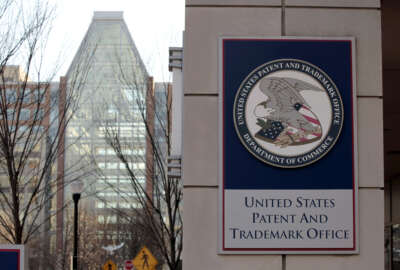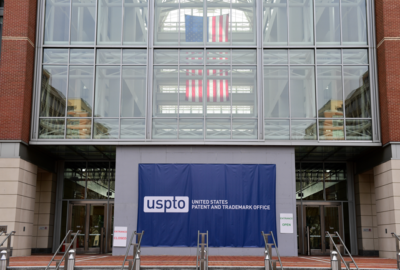Lobbyist for inventors says America Invents Act’s trial and appeal board ‘kills’ patents
Randy Landreneau is president of a group called US Inventor, which lobbies Congress to rewrite the law, and he joined Federal Drive with Tom Temin for more...
Best listening experience is on Chrome, Firefox or Safari. Subscribe to Federal Drive’s daily audio interviews on Apple Podcasts or PodcastOne.
A 2011 law called the America Invents Act established something called the Patent Trial and Appeal Board. And it changed the system from first-to-invent, to first-to-file. Randy Landreneau said the law is a mistake and needs to be changed back. He is president of a group called US Inventor, which lobbies Congress to rewrite the law, and he joined Federal Drive with Tom Temin for more discussion.
Interview transcript:
Tom Temin: Mr. Landreneau, good to have you on.
Randy Landreneau: Thanks for having me.
Tom Temin: And we should point out you have a couple of patents to your name, you are an inventor and work for a small company that has some patents. So you’re kind of part of the whole process yourself, correct?
Randy Landreneau: Yeah, I have a few patents and nothing that’s made it big yet, but still working on some things that for the future that we’ll see.
Tom Temin: Alright, so first of all, what is the issue with the America Invents Act from your standpoint of view? Is that the establishment of the PTAB or is it the change from first-to-invent to first-to-file?
Randy Landreneau: Yeah, there was a lot of argument back when the bill was being pushed about first-to-invent versus first-to-file. And you know what, that ended up being the least important aspect. What really became the problem is the establishment of the Patent Trial and Appeal Board called the PTAB, which is an administrative court, which was basically sold to Congress as “We need a faster, more efficient, less expensive, but fair alternative to district court for certain types of patent disputes.” And as you find in Washington, D.C., it was very reasonable argument is very compelling. And of course, it was coming from the lobbyists of huge corporations, including big tech. No inventors were listened to, as usual, because we’re not the guys with tons of money to lobby with.
What was created, though, was his administrative court, which became pretty much a killing field for patents. In fact, former Chief Judge [of the United States Court of Appeals for the Federal Circuit] Randall Rader referred to it as a death squad for patent rights. And that’s how we see it. And I can tell you a little bit about it. Prior to the creation of the PTAB, these disputes were all handled in real courts with juries. And let me tell you something you want a jury if you’re in a big situation that’s important where you’re innocent.
Tom Temin: What would decide in court and now by the PTAB is who actually had the rights to a particular patent, in other words?
Randy Landreneau: No, what it is, is okay – so this is an interesting question: If you are accused of patent infringement, you could argue that, well, we don’t infringe. Or you could argue that the patent was a mistake and shouldn’t have been issued. And those were the two arguments historically. But now with the PTAB the argument is always – I say always, maybe it’s not 100% but it’s pretty close to it – always it’s a bad patch, shouldn’t have been issued. Regardless of any facts or figures, that is the argument: It shouldn’t have been issued. And then they take it to the PTAB where, whether the patent should or should not have been issued is the issue. That’s what the PTAB is there for.
Tom Temin: So if one inventor say a small company, or a single sole practitioner type of inventor, achieves a patent, and then believes that patent is infringed on by somebody, like, I guess, a Chinese company or someone in the United States, the PTAB, you’re saying tends to agree with the argument that the patent itself was invalid?
Randy Landreneau: Right. So basically, yes, so you sue a big corporation or anybody but in many cases, what you’re talking about is suing the giants who are for whatever reason, unwilling to license inventions, because it’s easier to not. But much harder for the little guy to just stop them and make them pay so, especially now, so they will claim, well, you’re infringing. We don’t think we are. You sue them, or they say, go ahead, sue us, if you want. You sue them, they basically try to invalidate your patent then at the Patent Trial and Appeal Board, where basically, it’s an administrative court where in the past, this was done in a real court with a jury and a lot of due process and a lifetime-appointed judge.
But now you have an administrative court. There’s no jury, there’s very little due process, you don’t have all the various types of arguments and discovery and all that stuff. And the judges, instead of a real judge, you have three individuals who are called administrative patent judges. We have statistics that show that their experience, their technical experience in the technologies of these patents that they’re invalidating is way, way less than what the examiners have. The examiners are the experts. They’re the ones that issue these patents. But then you have these PTAB judges who have much less and sometimes no technical experience. Maybe an undergraduate degree, but their experience is typically as a lawyer, not as a person dealing with these technologies. And of course, I don’t know if you’re a lawyer or not, but – lawyers can argue all kinds of things. They’re kind of trained to do that. And what our statistics show is that 84% of the time that a patent is reviewed by the Patent Trial and Appeal Board, maybe 4% of the time, that it gets to a final decision. They are either fully or partially invalidated, and partially typically means the parts of the patent that matter. So in other words, the parts that are in dispute, and it is horrendous and it’s not cheap. In fact, the AIPLA – that’s the the big patent law trade group, right – AIPLA says that a decent defense of a PTAB attack is $400- to $800,000.
And here’s the killer: historically, inventors are not the rich guys, right? Steve Jobs didn’t have money when he started. Bill Gates didn’t have money. The great ideas, the outside-of-the-box thinking comes from the little guys and gals in a garage or wherever. They don’t have the money to fight a hugely expensive patent infringement suit. How do they do it? Well, historically, they did it on contingency where the attorney shares in the winnings, but you don’t have to pay the attorney a ton of money upfront. That has been destroyed because it’s PTAB, almost will never find an attorney who will do a PTAB case on contingency because, number one, there’s nothing to win. Number two, if you get through one PTAB attack you can actually face numerous additional ones. One of my friends faced eight of them.
Tom Temin: We’re speaking with Randy Landreneau, he’s president of US Inventor. So it sounds like the PTAB was created as a way to speed up what can be sometimes slow courts, and also to deal with the issue that was extant at that time of the patent troll. But it sounds like the unintended consequences have outweighed those benefits, is that basically what you’re think has happened?
Randy Landreneau: Oh gosh, that is so true. This is like the poster child for unintended consequences.
Tom Temin: Recently, the U.S. Patent and Trademark Office – I guess it’s been a couple of years now – granted the 10 millionth patent in history. How many have been invalidated, do you think in the past 10 years out of the PTAB?
Randy Landreneau: It’s interesting you bring that up because the district director for Sen. Patrick Leahy gave me an interesting question because we actually had a demonstration in front of his office, the 10-year anniversary of the passage of the bill. And it was Leahy’s bill and Leahy has got the top position on patents in the Senate. Basically, of the 3,000 patents – little over 3,000 that have been reviewed by the PTAB and gotten to a final written decision, 84% of which is 2,500-something have been invalidated. Now what this individual said to me, “Well wait a minute, what about last year, there were a few 100,000 patents issued, but only 600 of them went to the PTAB. So it’s a very small number.” No, but it’s the really valuable patents. A lot of patents issued that aren’t that valuable. I have three that so far have zero value, right? But the patents that are truly valuable, those are the ones that get infringed, get knocked off, and that you try to stop the infringer and they drag you into the PTAB.
This PTAB is used as a way to destroy the little guy because they can and it’s horrendous. And all we want – I mean, tell you something all we want is to be able, if you’re an inventor, and it’s your patent or you’re a startup based on a patent, all we want is the ability to opt for a real court rather than being dragged into PTAB. Like we had for 200 years. I actually don’t know if Sen. Leahy even knows about the unintended consequences of his bill. And I can tell you we’ve tried very hard to get him directly. And I think what he is listening to apparently, as far as we can tell is Big Tech.
Copyright © 2025 Federal News Network. All rights reserved. This website is not intended for users located within the European Economic Area.
Tom Temin is host of the Federal Drive and has been providing insight on federal technology and management issues for more than 30 years.
Follow @tteminWFED






